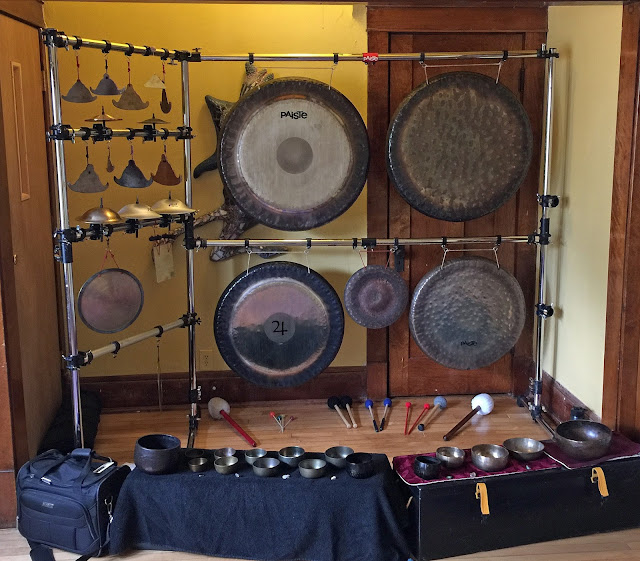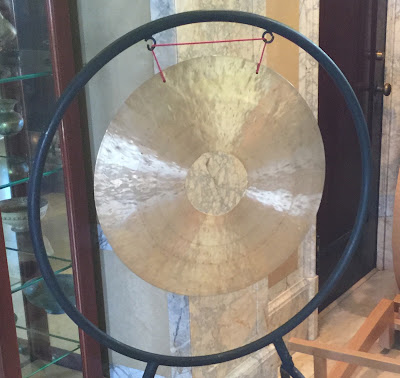Giving Your Practice A Voice
As I always do, I had a Q&A/Sharing time after last night's sound session. If there is time, I like to offer this, because people often have questions about all the different instruments, how I play them, what made what sound, etc. We also share our experiences, as everyone's is different and personal. Experiences like physical sensations, spiritual journeys, or audio/visual stimulation.
Voice As Meditation
Part of this is people explaining what they heard. Last night various people said they heard voices. This is a two fold experience.
1) Sound is deeply linked to memory. Often we hear things that sound like something we have heard before. In the case of the Gongs/Bowls/Bells, these instruments cover a very wide frequency range, and various sound/frequencies may trigger a memory of voices or vocal sounds. I have had people say that they hear singing, or choirs. I've also had people describe hearing strings or orchestras, which is a very similar type sound.
2) Hearing voices, or an actual voice, mine to be truthful. Often, like last night, I specifically vocalize when playing the large Gongs. I do it as much for myself, as for the people in attendance. One thing I do is overtone singing. I like to do this within inches of the face of the Gong. My voice both reflects back to me off the Gong, and also combines with the Gong's sound. When conditions are right, both sounds combine in an other worldly dance, creating a sympathetic resonance.
I also will chant directly into the face of the Gong. I find this chanting helps to keep me focused with its repetitive rhythm.
I listen to the sound of the Gong.
I listen to my voice.
I listen to how they combine.
In each case, I'm not looking to be a lead singer, where my voice rises about the music. Rather, I'm looking to blend in with the Gongs, becoming just another sound in the spectrum.
Chanting As A Permanent Practice
Chanting has a long historical tradition in most cultures. It's possible that chant goes back to the very beginnings of humanity, when we 1st gained self awareness and started doing things with purpose, not just instinct. Chant has been, and is still used today, by various religious and spiritual practices. It is both a discipline and a way to focus.
You may find that chanting deepens your experience of art as a spiritual practice. The rich, rhythmic vocal sounds have a way of connecting us with our past, our history, our lineage. But they also have a way of connecting us with the present moment.
Exercise #1:
Pick out a chant or mantra. It can be from any tradition. Start playing your Gong in a sustained fashion, creating a long, continuous tone that ebbs and flows. Start chanting, then listen to your voice. Also listen to the Gong. Listen to both and try to bring them together. Keep this going for 10 minutes or more. Do this everyday for at least a week and see how your practice develops. Notice if there is any change in your awareness of the sounds, of your time perception, and of your overall experience.
Exercise #2:
Start as in exercise #1, picking out a chant, only this time use a Gong, Bowl, Bell, shaker, or drum, and play a slow steady rhythm. When you get going, match the played rhythm to the rhythm of the chant and lock them together. Again, play of 10 or more minutes and continue for a week. Notice the changes experienced after the week.
The human voice is the original instrument. It is always with us and accessible. A regular chanting practice can help us to both relax and focus. It also deepens our sense of self and surroundings. When combined with our performance for others, it can help to form a deeper connection.
Chant.
Chant again.
Chant some more.
~ MB
Voice As Meditation
Part of this is people explaining what they heard. Last night various people said they heard voices. This is a two fold experience.
1) Sound is deeply linked to memory. Often we hear things that sound like something we have heard before. In the case of the Gongs/Bowls/Bells, these instruments cover a very wide frequency range, and various sound/frequencies may trigger a memory of voices or vocal sounds. I have had people say that they hear singing, or choirs. I've also had people describe hearing strings or orchestras, which is a very similar type sound.
2) Hearing voices, or an actual voice, mine to be truthful. Often, like last night, I specifically vocalize when playing the large Gongs. I do it as much for myself, as for the people in attendance. One thing I do is overtone singing. I like to do this within inches of the face of the Gong. My voice both reflects back to me off the Gong, and also combines with the Gong's sound. When conditions are right, both sounds combine in an other worldly dance, creating a sympathetic resonance.
I also will chant directly into the face of the Gong. I find this chanting helps to keep me focused with its repetitive rhythm.
I listen to the sound of the Gong.
I listen to my voice.
I listen to how they combine.
In each case, I'm not looking to be a lead singer, where my voice rises about the music. Rather, I'm looking to blend in with the Gongs, becoming just another sound in the spectrum.
Chanting As A Permanent Practice
Chanting has a long historical tradition in most cultures. It's possible that chant goes back to the very beginnings of humanity, when we 1st gained self awareness and started doing things with purpose, not just instinct. Chant has been, and is still used today, by various religious and spiritual practices. It is both a discipline and a way to focus.
You may find that chanting deepens your experience of art as a spiritual practice. The rich, rhythmic vocal sounds have a way of connecting us with our past, our history, our lineage. But they also have a way of connecting us with the present moment.
Exercise #1:
Pick out a chant or mantra. It can be from any tradition. Start playing your Gong in a sustained fashion, creating a long, continuous tone that ebbs and flows. Start chanting, then listen to your voice. Also listen to the Gong. Listen to both and try to bring them together. Keep this going for 10 minutes or more. Do this everyday for at least a week and see how your practice develops. Notice if there is any change in your awareness of the sounds, of your time perception, and of your overall experience.
Exercise #2:
Start as in exercise #1, picking out a chant, only this time use a Gong, Bowl, Bell, shaker, or drum, and play a slow steady rhythm. When you get going, match the played rhythm to the rhythm of the chant and lock them together. Again, play of 10 or more minutes and continue for a week. Notice the changes experienced after the week.
The human voice is the original instrument. It is always with us and accessible. A regular chanting practice can help us to both relax and focus. It also deepens our sense of self and surroundings. When combined with our performance for others, it can help to form a deeper connection.
Chant.
Chant again.
Chant some more.
~ MB
Chop Wood / Carry Water / Play Gongs™ / Chant






Comments
Post a Comment